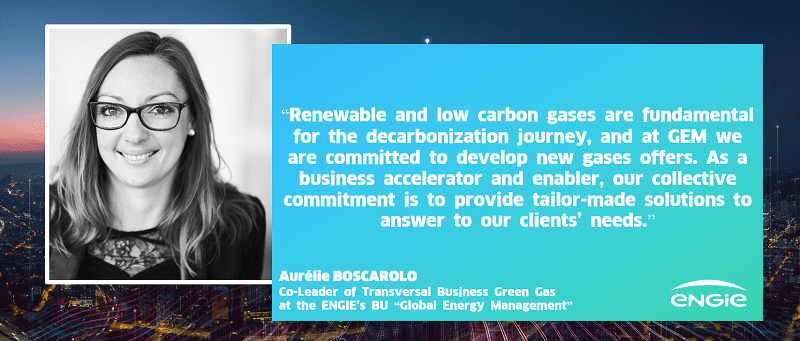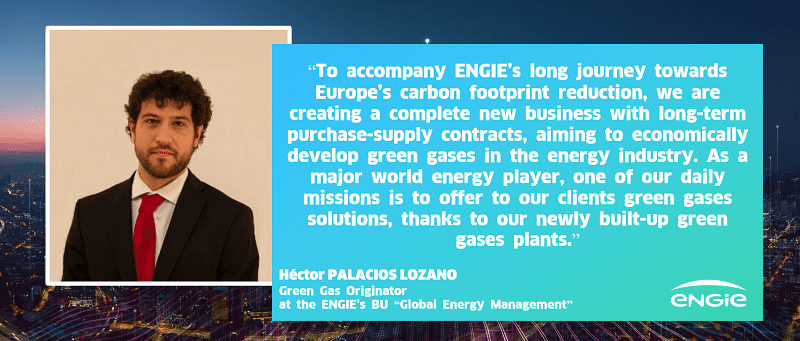Expert Paper | The future of renewable and low carbon gases
ENGIE’s purpose is to act to accelerate the transition towards a carbon-neutral world, through reduced energy consumption and more environmentally-friendly solutions. Its Global Business Unit ENGIE - International Supply & Energy Management is alongside in this reach for carbon-neutrality, ensuring connection between energy producers and consumers, and developing cutting-edge solutions adapted to the market. Renewable and low carbon gases are offering huge potential for our customers.
- Article
- 25/05/2021

What are we talking about?
Renewable and low carbon gases are gaseous energy sources having negative, neutral or low greenhouse gases footprint.
The first of these new gases generation is biomethane, which can be either produced locally from organic waste via anaerobic digestion or woody biomass via pyrogasification. From a chemical point of view, this gas is the same molecule as natural gas, and thus may be injected into the grid and used in an identical manner. Biomethane is a 100% renewable energy allowing major reductions in greenhouse gas emissions (seen from a life-cycle perspective) and improving air quality. So far, the biomethane market remains mainly national. However its significant, sustainable production potential should swiftly scale-up its development and make it a key driver of the evolution of the European gas market. Several policies instruments have been implemented in the last years at both European and national levels, while provisions set by the Renewable Energy Directive II (RED2) will allow cross-border exchanges of biomethane Guarantees of Origin throughout Europe from July 2021.
Then, renewable and low carbon hydrogen is also part of these new gases. Currently, hydrogen is mainly used for ammonia production, refineries and chemistry. There is no hydrogen wholesale market and this gas is produced on-site, distributed through private networks from a centralized plant or transported by trucks. It is today largely made from coal, hydrocarbons or natural gas without CO2 emissions capture. On the contrary, renewable or low carbon hydrogen relies on different technologies, all ensuring a low carbon intensity of the gas on its whole life cycle.
Which role and perspectives for the energy decarbonization?
In December 2019, the European Commission endorsed the objective of achieving a climate-neutral European Union by 2050 via the release of the “EU Green Deal” initiative, in line with the objectives of the Paris Agreement. To reach this ambitious goal, the most resilient and cost-effective pathway relies on multiple energy efficiency, renewable and low carbon technologies and sources.
In May 2020, the European Union announced a major Recovery and Resilience Plan, as the economic response to the Covid-19 crisis. A third of the total 1,8 b€ EU pluri-annual budget set for the 2021-2026 period will be earmarked to the Green Deal, thus to the energy transition in order to incentive innovation, development of renewable energy and decarbonization technologies.
Renewable and low carbon gases can be used for almost all energy end-use. In power generation, they are instrumental to balance a gradual, intermittent electricity production from wind and solar-PV with demand, and to respond to seasonal swings of consumption, ensuring adequacy and security of supply. Industrial, building and mobility sectors will also need sustainable energy for heat and steam generation from dispatchable sources. And in heavy industry, these new gases are essential to reach a full decarbonization, electrification having a limited potential depending on the sectors.
These gases will be available at large scale. The International Energy Agency (IEA) estimates the current production potential for biomethane above 1 300 TWh/y in Europe [1], allowing to reach 40% of gas demand by 2040. On hydrogen side, the worldwide potential can reach a tenfold production compared to current consumption [2], corresponding to more than 2 000 TWh/y in Europe.
According to Gas for Climate [3], the use of gases will save society over €200 billion annually across the energy system by 2050 at EU level, compared to other decarbonization scenarios based on high electrification. Furthermore, those gases contribute to reduce societal cost, increase optionality thanks to their dispatchability and sustainability properties, and even foster rural employment !
What are ENGIE’s offers in terms of renewable and low carbon gases?
Renewable and low carbon gases have become a very important business development in which ENGIE is committed. Similarly to green power, we ambition to expand our midstream role, connecting upstream and downstream markets for renewable and low-carbon gases.
Our objective being to decarbonize ENGIE’s assets and help our clients to do so, we have been building a significant portfolio of biomethane (10 TWh/year in France by 2034) and are currently involved in different hydrogen projects based on various technologies around the world.
Thanks to our expertise, we are already able to offer a large range of solutions to reduce the carbon footprint of our clients. Indeed, from guarantees of origin to gas purchase agreement, we design tailor-made solutions that will make a greener world.
[1] https://webstore.iea.org/download/direct/2970?fileName=Outlook_for_biogas_and_biomethane.pdf
[2] https://hydrogencouncil.com/wp-content/uploads/2021/01/Hydrogen-Council-Report_Decarbonization-Pathways_Part-2_Supply-Scenarios.pdf
[3] https://gasforclimate2050.eu/wp-content/uploads/2020/03/Navigant-Gas-for-Climate-The-optimal-role-for-gas-in-a-net-zero-emissions-energy-system-March-2019.pdf
Testimonies:


